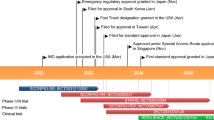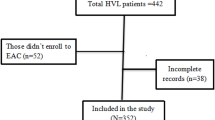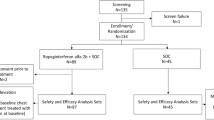Abstract
Purpose of Review
The purpose of this paper is to review therapies with new mechanisms of action for the treatment of HIV that are at least in phase 2 clinical trials.
Recent Findings
There are several new mechanisms of action being represented within clinical development, including histone deacetylase (HDAC) inhibitors, gene therapies, broadly neutralizing anti-HIV antibodies, immune modulation, and drugs with new mechanisms to block HIV entry. The new therapies are being developed for both as add-on therapy to existing combination antiretroviral therapy and as agents to be used during treatment interruption. The current drugs in development have had varying degrees of success in the early trials.
Summary
Each of these new drugs may potentially fill a void in current antiretroviral therapy (ART) therapies, which will ultimately lead to improved outcomes in HIV-infected individuals.
Similar content being viewed by others
References
Papers of particular interest, published recently, have been highlighted as: • Of importance
WHO. World Health Organization HIV/AIDS Fact Sheet [Internet]. 2017 [cited 2017 Aug 1]. Available from: http://www.who.int/mediacentre/factsheets/fs360/en/
CDC. Centers for Disease Control and Prevention HIV Fact Sheet [Internet]. 2017. Available from: https://www.cdc.gov/hiv/library/factsheets/index.html
Nettles RE, Schurmann D, Zhu L, Stonier M, Huang SP, Chang I, et al. Pharmacodynamics, safety, and pharmacokinetics of BMS-663068, an oral HIV-1 attachment inhibitor in HIV-1-infected subjects. J Infect Dis. 2012;206:1002–11.
Lalezari JP, Latiff GH, Brinson C, Echevarría J, Treviño-Pérez S, Bogner JR, et al. Safety and efficacy of the HIV-1 attachment inhibitor prodrug BMS-663068 in treatment-experienced individuals: 24 week results of AI438011, a phase 2b, randomised controlled trial. Lancet HIV. 2015;2:e427–37.
ClinicalTrials.gov. clinicaltrials.gov NCT02362503 [Internet]. 2017 [cited 2017 Jul 23]. Available from: https://clinicaltrials.gov/ct2/show/NCT02362503
Jacobson JM, Thompson MA, Lalezari JP, Saag MS, Zingman BS, D’Ambrosio P, et al. Anti-HIV-1 activity of weekly or biweekly treatment with subcutaneous PRO 140, a CCR5 monoclonal antibody. J Infect Dis. 2010;201:1481–7.
Jacobson JM, Lalezari JP, Thompson MA, Fichtenbaum CJ, Saag MS, Zingman BS, et al. Phase 2a study of the CCR5 monoclonal antibody PRO 140 administered intravenously to HIV-infected adults. Antimicrob Agents Chemother. 2010;54:4137–42.
• Margolis DM, Garcia JV, Hazuda DJ, Haynes BF. Latency reversal and viral clearance to cure HIV-1. Science. 2016;353:aaf6517. This article provides a concise review of strategies targeted towards HIV eradication.
Romerio F, Gabriel MN, Margolis DM. Repression of human immunodeficiency virus type 1 through the novel cooperation of human factors YY1 and LSF. J Virol. 1997;71:9375–82.
Coull JJ, Romerio F, Sun J-M, Volker JL, Galvin KM, Davie JR, et al. The human factors YY1 and LSF repress the human immunodeficiency virus type 1 long terminal repeat via recruitment of histone deacetylase 1. J Virol. 2000;74:6790–9.
He G, Margolis DM. Counterregulation of chromatin deacetylation and histone deacetylase occupancy at the integrated promoter of human immunodeficiency virus type 1 (HIV-1) by the HIV-1 repressor YY1 and HIV-1 activator Tat. Mol Cell Biol. 2002;22:2965–73.
Ylisastigui L, Coull JJ, Rucker VC, Melander C, Bosch RJ, Brodie SJ, et al. Polyamides reveal a role for repression in latency within resting T cells of HIV-infected donors. J Infect Dis. 2004;190:1429–37.
Jiang G, Espeseth A, Hazuda DJ, Margolis DM. c-Myc and Sp1 contribute to proviral latency by recruiting histone deacetylase 1 to the human immunodeficiency virus type 1 promoter. J. Virol. 2007;81:10914–23.
Pearson R, Kim YK, Hokello J, Lassen K, Friedman J, Tyagi M, et al. Epigenetic silencing of human immunodeficiency virus (HIV) transcription by formation of restrictive chromatin structures at the viral long terminal repeat drives the progressive entry of HIV into latency. J Virol. 2008;82:12291–303.
Seto E, Yoshida M. Erasers of histone acetylation: the histone deacetylase enzymes. Cold Spring Harb Perspect Biol. 2014;6:a018713.
Mann BS, Johnson JR, Cohen MH, Justice R, Pazdur R. FDA approval summary: vorinostat for treatment of advanced primary cutaneous T-cell lymphoma. Oncologist. 2007;12:1247–52.
Elliott JH, Wightman F, Solomon A, Ghneim K, Ahlers J, Cameron MJ, et al. Activation of HIV transcription with short-course vorinostat in HIV-infected patients on suppressive antiretroviral therapy. PLoS Pathog. 2014;10:e1004473.
Archin NM, Liberty AL, Kashuba ADM, Choudhary SK, Kuruc JD, Crooks AM, et al. Administration of vorinostat disrupts HIV-1 latency in patients on antiretroviral therapy. Nature. The University of North Carolina at Chapel Hill, Chapel Hill, North Carolina 27599, USA: Nat Publ Group; 2012;487:482–485.
Archin NM, Bateson R, Tripathy MK, Crooks AM, Yang K-H, Dahl NP, et al. HIV-1 expression within resting CD4+ T cells after multiple doses of vorinostat. J Infect Dis. 2014;210:728–35.
ClinicalTrials.gov. ClinicalTrials.gov [Internet]. 2017 [cited 2017 Aug 22]. Available from: https://clinicaltrials.gov/ct2/results?term=vorinostat&cond=Hiv
Rasmussen TA, Tolstrup M, Brinkmann CR, Olesen R, Erikstrup C, Solomon A, et al. Panobinostat, a histone deacetylase inhibitor, for latent virus reactivation in HIV-infected patients on suppressive antiretroviral therapy: a phase 1/2, single group, clinical trial. Lancet HIV. 2014;1:e13–21.
ClinicalTrials.gov. clinicaltrials.gov NCT02471430 [Internet]. 2017 [cited 2017 Aug 22]. Available from: https://www.clinicaltrials.gov/ct2/show/NCT02471430
Søgaard OS, Graversen ME, Leth S, Olesen R, Brinkmann CR, Nissen SK, et al. The depsipeptide romidepsin reverses HIV-1 latency in vivo. PLoS Pathog. 2015;11:1–22.
Rasmussen TA, Lewin SR. Shocking HIV out of hiding: where are we with clinical trials of latency reversing agents? Curr Opin HIV AIDS. 2016;11:1.
ClinicalTrials.gov. clinicaltrials.gov NCT01933594 [Internet]. 2017 [cited 2017 Jul 23]. Available from: https://clinicaltrials.gov/ct2/show/NCT01933594?term=NCT01933594&rank=1
ClinicalTrials.gov. clinicaltrials.gov NCT03041012 [Internet]. 2017 [cited 2017 Jul 28]. Available from: https://clinicaltrials.gov/ct2/show/NCT03041012?term=romidepsin&cond=Hiv&rank=4
Millard CJ, Watson PJ, Fairall L, Schwabe JWR. Targeting class I histone deacetylases in a “complex” environment. Trends Pharmacol Sci Elsevier Ltd. 2017;38:363–77.
Kobayashi Y, Gélinas C, Dougherty JP. Histone deacetylase inhibitors containing a benzamide functional group and a pyridyl cap are preferentially effective human immunodeficiency virus-1 latency-reversing agents in primary resting CD4+ T cells. J Gen Virol. 2017;98:799–809.
ClinicalTrials.gov. clinicaltrials.gov NCT02513901 [Internet]. 2017 [cited 2017 Jul 28]. Available from: https://clinicaltrials.gov/ct2/show/NCT02513901
ClinicalTrials.gov. clinicaltrials.gov NCT02902185 [Internet]. 2016 [cited 2017 Aug 22]. Available from: https://clinicaltrials.gov/ct2/show/NCT02902185?term=NCT02902185&rank=1
Khot A, Dickinson M, Prince HM. Panobinostat in lymphoid and myeloid malignancies. Expert Opin Investig Drugs. 2013;22:1211–23.
Asmuth DM, Utay NS, Pollard RB. Peginterferon 2a for the treatment of HIV infection. Expert Opin Investig Drugs Taylor & Francis. 2016;25:249–57.
Asmuth DM, Murphy RL, Rosenkranz SL, Lertora JJL, Cramer Y, Chan ES, et al. Safety, tolerability and mechanisms of antiretroviral activity of peginterferon alfa-2a in HIV-1-mono-infected subjects: a phase II clinical trial. J Infect Dis. 2010;201:1686–96.
ClinicalTrials.gov. clinicaltrials.gov NCT00078442 [Internet]. 2009 [cited 2017 Jul 28]. Available from: https://clinicaltrials.gov/ct2/show/NCT00078442?term=NCT00078442&rank=1
ClinicalTrials.gov. clinicaltrials.gov NCT02227277 [Internet]. 2017 [cited 2017 Aug 22]. Available from: https://clinicaltrials.gov/ct2/show/NCT02227277?term=NCT02227277&rank=1
ClinicalTrials.gov. clinicaltrials.gov NCT01935089 [Internet]. 2016 [cited 2017 Aug 20]. Available from: https://clinicaltrials.gov/ct2/show/NCT01935089?term=NCT01935089&rank=1
ClinicalTrials.gov. clinicaltrial.gov NCT00125814 [Internet]. 2005 [cited 2017 Aug 20]. Available from: https://clinicaltrials.gov/ct2/show/NCT00125814?term=NCT00125814&rank=1
ClinicalTrials.gov. clinicaltrials.gov NCT00594880 [Internet]. 2015 [cited 2017 Aug 22]. Available from: https://clinicaltrials.gov/ct2/show/results/NCT00594880?term=NCT00594880&rank=1
Goujard C, Emilie D, Roussillon C, Godot V, Rouzioux C, Venet A, et al. Continuous versus intermittent treatment strategies during primary HIV-1 infection. AIDS. 2012;26:1895–905.
Boué F, Reynes J, Rouzioux C, Emilie D, Souala F, Tubiana R, et al. Alpha interferon administration during structured interruptions of combination antiretroviral therapy in patients with chronic HIV-1 infection: INTERVAC ANRS 105 trial. AIDS. 2011;25:115–8.
Azzoni L, Foulkes AS, Papasavvas E, Mexas AM, Lynn KM, Mounzer K, et al. Pegylated interferon alfa-2a monotherapy results in suppression of HIV type 1 replication and decreased cell-associated HIV DNA integration. J Infect Dis. 2013;207:213–22.
Rivero-Juárez A, Frias M, Rivero A. Current views on interferon therapy for HIV. Expert Opin Biol Ther Taylor & Francis. 2016;2598:1–8.
Azzoni L, Papasavvas E, Lynn K, Kapalko A, Lalley-Chareczko L, Tebas P, et al. A Feasibility study of weight-based pegylated IFN-alpha2b immunotherapy to target persistent HIV-1 on ART. Int. AIDS Soc. Annu. Meet. Vancouver, Canada; 2015. p. Poster:TUPEB297.
• Caskey M, Klein F, Nussenzweig MC. Broadly neutralizing antibodies for HIV-1 prevention or immunotherapy. N Engl J Med. 2016;375:2019–21. This article provides a general overview of the use of broadly neutralizing antibodies for the treatment of HIV.
Bar KJ, Sneller MC, Harrison LJ, Justement JS, Overton ET, Petrone ME, et al. Effect of HIV antibody VRC01 on viral rebound after treatment interruption. N Engl J Med. 2016;375:2037–50.
Ledgerwood JE, Coates EE, Yamshchikov G, Saunders JG, Holman L, Enama ME, et al. Safety, pharmacokinetics and neutralization of the broadly neutralizing HIV-1 human monoclonal antibody VRC01 in healthy adults. Clin Exp Immunol. 2015;182:289–301.
Lynch RM, Boritz E, Coates EE, Dezure A, Madden P, Costner P, et al. Virologic effects of broadly neutralizing antibody VRC01 administration during chronic HIV-1 infection. Sci Transl Med. 2015;7:319ra206.
Scheid JF, Horwitz JA, Bar-On Y, Kreider EF, Lu C-L, Lorenzi JCC, et al. HIV-1 antibody 3BNC117 suppresses viral rebound in humans during treatment interruption. Nature. 2016;535:556–60.
Steens J-M, Scherrer D, Gineste P, Barrett PN, Khuanchai S, Winai R, et al. Safety, pharmacokinetics, and antiviral activity of a novel HIV antiviral, ABX464, in treatment-naive HIV-infected subjects in a phase 2 randomized, controlled study. Antimicrob Agents Chemother. 2017;61:1–27.
Scherrer D, Rouzier R, Cardona M, Barrett PN, Steens J-M, Gineste P, et al. Food effect on pharmacokinetic parameters of ABX464 administered orally: a randomized trial in healthy male subjects. Antimicrob Agents Chemother. 2017;61:e01288–16.
Scherrer D, Rouzier R, Noel Barrett P, Steens J-M, Gineste P, Murphy RL, et al. Pharmacokinetics and tolerability of ABX464, a novel first-in-class compound to treat HIV infection, in healthy HIV-uninfected subjects. J Antimicrob Chemother. 2017;72:820–8.
Tebas P, Stein D, Ww T, Frank I, Sq W, Lee G, et al. Gene editing of CCR5 in autologous CD4 T cells of persons infected with HIV. N Engl J Med. 2014;370:901–10.
Zeidan J, Lee GK, Benne C, Fourati S, Wang SK, Lalezari JP, et al. T-Cell Homeostasis and CD8 Responses Predict Viral Control Post SB-728-T Treatment [Internet]. Conf. Retroviruses Opportunistic Infect. 2016 [cited 2017 Aug 19]. Available from: http://www.croiconference.org/sessions/t-cell-homeostasis-and-cd8-responses-predict-viral-control-post-sb-728-t-treatment
ClinicalTrials.gov. clinicaltrials.gov NCT00295477 [Internet]. 2016 [cited 2017 Jul 28]. Available from: https://clinicaltrials.gov/ct2/show/NCT00295477?term=NCT00295477&rank=1
Tebas P, Stein D, Binder-Scholl G, Mukherjee R, Brady T, Rebello T, et al. Antiviral effects of autologous CD4 T cells genetically modified with a conditionally replicating lentiviral vector expressing long antisense to HIV. Blood. 2013;121:1524–33.
Author information
Authors and Affiliations
Corresponding author
Ethics declarations
Conflict of Interest
Drs. Gravatt, McRae, Ms. Leibrand, and Mr. Sulay declare no conflicts of interests in regard to the development of this paper.
Human and Animal Rights and Informed Consent
All reported studies/experiments with human or animal subjects performed by the authors have been previously published and complied with all applicable ethical standards.
Additional information
This article is part of the Topical Collection on Antimicrobial Development and Drug Resistance
Rights and permissions
About this article
Cite this article
Gravatt, L.A.H., Leibrand, C.R., Patel, S. et al. New Drugs in the Pipeline for the Treatment of HIV: a Review. Curr Infect Dis Rep 19, 42 (2017). https://doi.org/10.1007/s11908-017-0601-x
Published:
DOI: https://doi.org/10.1007/s11908-017-0601-x




